| Construction Rating: | starstarstarstar_borderstar_border |
| Flight Rating: | starstarstarstarstar_border |
| Overall Rating: | starstarstarstar_borderstar_border |
| Manufacturer: | Estes  |
Brief:
This is a single-staged, standoff-scale model of a Patriot test round.
Construction:
Other reviewers have done excellent breakdowns on the kit contents, so I will not repeat them here. However, one change is that my Patriot came with the new, cheap rubber band shock cord. This was immediately canned!
The Patriot is a decent model in stock form. The majority of the components are good quality stuff and the flying abilities of these models are excellent. My "mission" with this kit was to preserve its good tendencies while improving its durability and reliability.
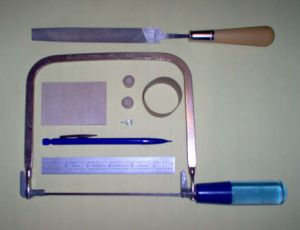 As supplied, the Patriot has several "gotchas" during construction. The instructions are certainly good, but I decided early on that I didn't want to build this model as supplied. It comes with 3 separate body tubes which are joined using couplers. Alignment issues are likely to arise here. Rather than tempt fate, the two 6-5/8" white body tubes and one coupler were set aside and used for other projects. The 3-1/4" yellow forward section was converted into an actual payload section. The two 6-5/8" tubes were replaced with a single piece of BT-60 cut to 13-1/4".
As supplied, the Patriot has several "gotchas" during construction. The instructions are certainly good, but I decided early on that I didn't want to build this model as supplied. It comes with 3 separate body tubes which are joined using couplers. Alignment issues are likely to arise here. Rather than tempt fate, the two 6-5/8" white body tubes and one coupler were set aside and used for other projects. The 3-1/4" yellow forward section was converted into an actual payload section. The two 6-5/8" tubes were replaced with a single piece of BT-60 cut to 13-1/4".
The inside of the motor mount tube, the first 1" of the BT, and the exposed part to the coupler tube were all painted with thin CA and sanded smooth for durability and reduced friction.
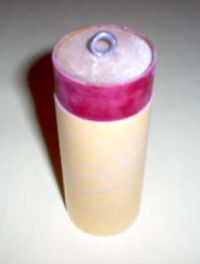 I have a simple method for making bulk plates for payload sections. It can be done easily with simple hand tools. First, use a .5mm mechanical pencil to trace the inside diameter of the coupler onto a piece of plywood (1/16" aircraft ply works well for model rockets up to BT-60 size). Then use a coping saw to cut it out. Stay close to the circle, but don't cut on the line. Test fit with the coupler. If it won't go, you can use a coarse file to rough finish it followed by sandpaper to fine finish it. When you're satisfied with the fit, cut a 1/2" long piece of 1/2" diameter dowel. Next, use a ruler to lay out the center of the bulk plate. Drill a hole through the center. Now, epoxy on your piece of dowel, over the center. After the epoxy has set, drill a pilot hole for your screw eye. Put a drop of epoxy or CA on the pilot hole and the screw eye threads before twisting in the screw eye. Put a ring of thick CA or 5-minute epoxy at the very inside edge of the coupler and slide in the bulkplate until it rests about 1/16" in from the edge. Allow the epoxy or CA to set. After your adhesive has set, fill the bulk plate with epoxy of your choice. Use just enough to cover the plate and touch the inside edge of the coupler. A thin layer is all you need! After your epoxy sets, you can now glue the coupler into the payload section. That's how it was done on my Patriot and you can use this method on pretty much any model you wish to add a payload section to up to BT-80 size.
I have a simple method for making bulk plates for payload sections. It can be done easily with simple hand tools. First, use a .5mm mechanical pencil to trace the inside diameter of the coupler onto a piece of plywood (1/16" aircraft ply works well for model rockets up to BT-60 size). Then use a coping saw to cut it out. Stay close to the circle, but don't cut on the line. Test fit with the coupler. If it won't go, you can use a coarse file to rough finish it followed by sandpaper to fine finish it. When you're satisfied with the fit, cut a 1/2" long piece of 1/2" diameter dowel. Next, use a ruler to lay out the center of the bulk plate. Drill a hole through the center. Now, epoxy on your piece of dowel, over the center. After the epoxy has set, drill a pilot hole for your screw eye. Put a drop of epoxy or CA on the pilot hole and the screw eye threads before twisting in the screw eye. Put a ring of thick CA or 5-minute epoxy at the very inside edge of the coupler and slide in the bulkplate until it rests about 1/16" in from the edge. Allow the epoxy or CA to set. After your adhesive has set, fill the bulk plate with epoxy of your choice. Use just enough to cover the plate and touch the inside edge of the coupler. A thin layer is all you need! After your epoxy sets, you can now glue the coupler into the payload section. That's how it was done on my Patriot and you can use this method on pretty much any model you wish to add a payload section to up to BT-80 size.
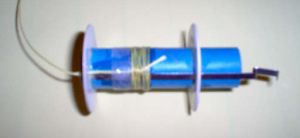 The other issues dealt with here were the marginal recovery system and the tendency of this model to shed fins. In addition to disposing of the rubber band shock cord, the mounting method was revised. A small groove was filed on the inside diameter of the front centering ring to pass a piece of 90 lb. Kevlar® thread. A knot was tied in the end of this and it was threaded through the clip retaining ring on the motor mount. The forward ring was then slid into place and glued as normal. Then the motor mount was painted with a thin layer of 5-minute epoxy and wrapped with about twenty turns of Kevlar® shroud line. This method is simple, lightweight, and produces a nuclear bombproof shock cord mount. 18" of Kevlar® was used. The mount was installed according to directions. After drying, 3 feet of 1/8" sewing elastic was tied to the end of the Kevlar®. A 12" Thrustline mylar chute replaced the prefab kit chute and was attached using a snap swivel.
The other issues dealt with here were the marginal recovery system and the tendency of this model to shed fins. In addition to disposing of the rubber band shock cord, the mounting method was revised. A small groove was filed on the inside diameter of the front centering ring to pass a piece of 90 lb. Kevlar® thread. A knot was tied in the end of this and it was threaded through the clip retaining ring on the motor mount. The forward ring was then slid into place and glued as normal. Then the motor mount was painted with a thin layer of 5-minute epoxy and wrapped with about twenty turns of Kevlar® shroud line. This method is simple, lightweight, and produces a nuclear bombproof shock cord mount. 18" of Kevlar® was used. The mount was installed according to directions. After drying, 3 feet of 1/8" sewing elastic was tied to the end of the Kevlar®. A 12" Thrustline mylar chute replaced the prefab kit chute and was attached using a snap swivel.
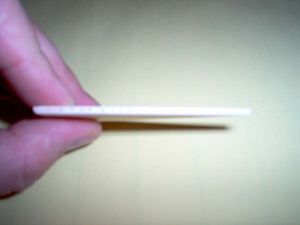 To solve the fin "spitting" problem, the tube was laid out to receive the fins, and a needle used to poke holes in it at 1/8" intervals on each line. The fins themselves also received the holes. This will allow the glue to sink into the fins and penetrate the tube surface, providing a much stronger bond. The fins were attached with gel CA then wood glue was used to make strong fillets.
To solve the fin "spitting" problem, the tube was laid out to receive the fins, and a needle used to poke holes in it at 1/8" intervals on each line. The fins themselves also received the holes. This will allow the glue to sink into the fins and penetrate the tube surface, providing a much stronger bond. The fins were attached with gel CA then wood glue was used to make strong fillets.
Finishing:
Other than the potential for one "gotcha" here, finishing is textbook easy. If built stock, you will end up with a big line, and perhaps even a gap, right in the middle of the main BT. Use a single piece BT and this becomes a non-issue.
Finishing is about as easy as it gets on a multi-color model. The coupler on the payload section was masked, and the coupler primed with white Krylon primer. This was lightly sanded, then shot with Krylon yellow. The fins were brushed with thinned Elmer's Carpenter's Finishing Wood Filler. When this had dried, the fins were sanded smooth and the entire main rocket was shot with Krylon white primer. This was sanded, recoated, and sanded again. Then the whole thing was shot with Krylon gloss white. The nose cone also received two coats of gloss white. The parts were set aside for a week, then the payload section and main were masked to receive the red paint. A 1" band on the top of the payload section, and the entire fin "can", were shot with Krylon red. The nose cone was CAREFULLY dipped into a jar of Testors silver. (Yes, I know it's cheesy but it works pretty good!)
After giving the paint plenty of time to cure, the decals were dipped into a dish of warm water with 2 drops of dish detergent in it. They were carefully moved into place, the bubbles eased out and they were blotted down with a clean rag.
After everything had dried, the rocket was given an overall coat of Testors clear enamel. Normally, I use Krylon clear, but this does NOT agree with the Testors silver on the nose! That's all there is to it. The end product is a colorful and attractive rocket.
Construction and painting went very well on this model but as supplied it could have gotten pretty hairy. I'll have to ding Estes a couple of points for the lousy recovery system and oddball multi-piece body tube.
Construction Rating: 3 out of 5
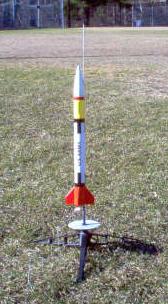 Flight:
Flight:
Went to O'Dell Park here in Franklin yesterday afternoon. The weather was absolutely beautiful. It was around 60 degrees with bright sunshine and a very slight, intermittent breeze.
In addition to the Patriot, I took an Edmonds Cici and two free Applewhite designs to test for classes.
The Patriot was flown a total of four times; once on an A8-3 and then I ran a pack of B6-4's through it.
Worm bedding wadding was used each flight, along with 2 squares of Estes wadding to provide a tight seal against the inside of the body tube. The tube was filled with worm bedding for 2 diameters depth, then the Estes squares placed on top.
I will have to go along with the general opinion that A8-3's are a poor choice for this design. Mine had attained only about 100 feet at motor burnout; it then arced slowly over and dropped heart-stoppingly low before ejection. There was no damage but this was more due to the soft grass than anything else.
The B6-4 flights were all picture-perfect. Each boost was very straight with no oscillation. Weathercocking was nonexistent. The Patriot with this motor ejects slightly after apogee. The first flight it was horizontal. The next 2, it had arced over and just begun to drop nose first.
The Thrustline 12" mylar parachute is a worthwhile upgrade for this kit. It inflates quickly and visibility in the sunlit sky is great. The upgrades to the shock cord (Kevlar mount and lengthened, 1/8" fabric elastic cord) are also an improvement. Everything works well with no snap-backs, tangles, or other miseries.
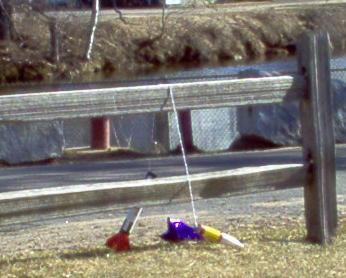 I feel that after 14 years, the Patriot has regressed somewhat from the terrific value it used to be. In stock form, it would still be a good flyer. With improvements, it also has the potential for long life and improved function. With that said, my original assessment given in the review would have to stand (I nailed Estes for the construction and material changes.) The Patriot receives 5 flight points. She just couldn't have flown better!
I feel that after 14 years, the Patriot has regressed somewhat from the terrific value it used to be. In stock form, it would still be a good flyer. With improvements, it also has the potential for long life and improved function. With that said, my original assessment given in the review would have to stand (I nailed Estes for the construction and material changes.) The Patriot receives 5 flight points. She just couldn't have flown better!
The entire launch went off like clockwork and was done in under an hour.
Flight Rating: 4 out of 5
Summary:
The Estes Patriot is a good kit that needs a little help.
PROs: They are proven flyers with attractive looks. Most of the components are high quality. Instructions are very clear.
CONs: The recovery system is cheap and fragile. Multiple tube construction method offers several possibilities for construction problems as well as finish issues.
Overall Rating: 3 out of 5
Other Reviews
- Estes Enduring Freedom Patriot M104 By Carl Tulanko
Brief: The Estes MK-104 Patriot Missile rocket kit is one of four new Estes "Military" kits and a very popular kit at the flying field. I purchased the Patriot along with the other three kits and the version I built was the "Launchable" kit in the hard-shell pack from Meijers. It is a very colorful model, appears pretty sturdy, and flies on 18mm motors. Included with the kit is an ...
- Estes Enduring Freedom Patriot M104 By Joseph Michel
Estes Enduring Freedom M-104 Patriot Missile. Modified recovery system and motor mount. Modifications: I modified the stock kit to accept a 24MM motor tube. This was accomplished using a rotary tool and 50-grit sanding drum to open up the stock centering ring to accept the 24MM tube. Once the centering rings were fitted to the motor tube, I also modified the motor hook. I never much cared for ...
- Estes Enduring Freedom Patriot M104 By Jon Revelle
A beautiful remake of the M-104 Patriot missile from Estes. This pup was re-released because of our recent victory over seas. This kit is un-assembled and comes with: 2 white body tubes 1 short yellow tube 1 nose cone 4 balsa fins 1 motor mount tube 1 mylar ring 2 engine tube holder rings 1 shockcord, parachute and shockcord mount 2 decal sheets PROS: ...
 |
 |
Flights
 |
 |